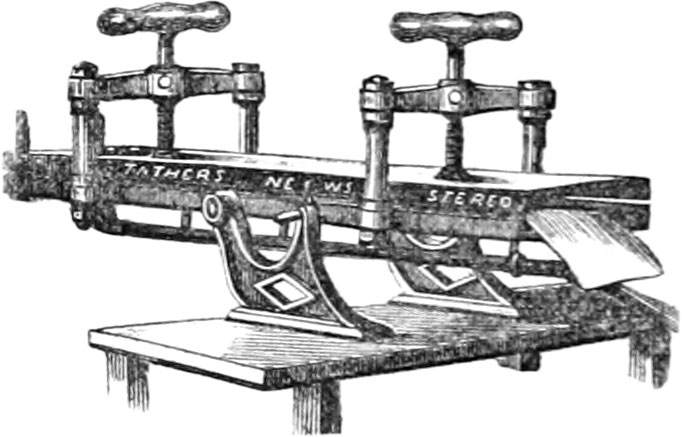Stereotyping
The art of taking casts or stereotype plates from types, woodcuts, &c. The two principal methods of stereotyping, as now practised, are called respectively the “Plaster Process” and the “Papier Maché Process.” Most of the principal newspapers are now printed from stereotype plates. For an account of the invention, see “Johnson’s Typographia,” Vol. II., p. 657; “Abridgement of Specifications Relating to Printing.” Vol. I., pp. 93–95.
The annexed engraving is a view of an exceedingly economical and useful stereotyping apparatus manufactured by Mr. Temple, of Hull.

This machine is adapted for plates of small jobs and pages of books; for a newspaper columns a different shaped apparatus is required, such as that illustrated below, which is supplied by Mr. Tather, of Hull, and is highly recommended to newspaper proprietors.

Matter for stereotyping should be set with stereotype spaces and quadrats (which are much higher than those used in ordinary founts), and the formes should be small, with type-high clumps at top and bottom, for protecting the ends of the plates from injury while they are passing through the machine during the shaving process. The formes should be locked up tight and square, evenly planed down and free from all dirt or ink on the face.
Stereotyping
The art of taking casts or stereotype plates from types, woodcuts, &c. The two principal methods of stereotyping, as now practised, are called respectively the “Plaster Process” and the “Papier Maché Process.” Most of the principal newspapers are now printed from stereotype plates. For an account of the invention, see “Johnson’s Typographia,” Vol. II., p. 657; “Abridgement of Specifications Relating to Printing,” Vol I., pp. 93–95.
Matter for stereotyping by the plaster process should be set with stereotype spaces and quadrats (which are much higher than those used in ordinary founts), as they avoid the necessity of picking out the plaster before distributing. Formerly, pages for stereotyping used to be imposed in quarto chases, but pages of newspapers and bookwork formes are now cast entire. Clumps are placed round the pages, and are bevelled on the inner edge near the face of the type, for the purpose of casting that portion of the plate where the catches fix on in imposition, and by which the “dogs” of the lathe hold the plate whilst the back is being turned or planed. The formes should be locked up light and square, evenly planed down, and free from all dirt or ink on the face.